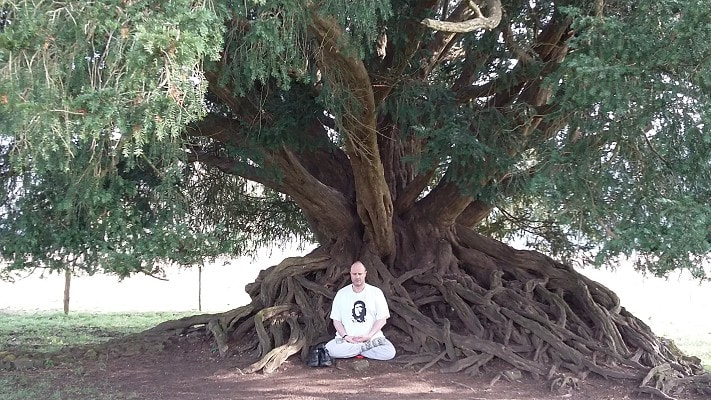The Standard Sanskrit Dictionary defines the term ‘Paravritti’ (परावृत्ति) in the following ways:
barter, rebounding, revolving, change, recoiling, turning back or round, exchange, restoration of property, interchange, returning, not taking effect, reversion of a sentence or judgement and turning about.
Within the context of Mahayana Buddhist Sanskrit (as used in the Lankavatara Sutra), the term Paravritti’ (परावृत्ति) means: ‘change’, ‘turning around’, ‘returning’ and ‘turning about’.
It implies the permanent ‘turning about’ (as a ‘realised’ achievement of enlightenment) that occurs in the deepest (alaya-vijnana) level of the mind. The ‘deluded’ mind – which is the mind that first embarks upon the path of enlightenment – is ‘inverted’ by nature and definition of the Buddha. To rid the mind of this ‘suffering-inducing’ inversion of mind, an individual must participate in the practice of meditation as a method of effective self-cultivation. Within the Chinese Ch’an School this process involves the use of gong-an contemplation and hua tou investigation. When the inner potential is suitably strengthened, there is a ‘breakthrough’ so that the ridgepole of ignorance is broken, and the inverted-mind is rectified into the non-inverted mind of complete enlightenment. A very good definition of ‘turning about’ (Paravritti) is as follows:
‘Discrimination not rising, there is a turning-back (parāvṛtti), and there is no dependence on anything … When there is a revulsion (parāvṛtti) from discrimination, one is removed from death and destruction; … " (* 8) Gotra (眞性) according to T'ang. (* 9) Parāvṛtti, turning-over, or turning-up, or turning-back’
This ‘turning about’ equates to the third position of the Cao Dong Five Ranks – where the ridge-pole if ignorance is finally broken and a ‘still’ and ‘peaceful’ state of mind is attained. Although only the ‘relative’ (or ‘Hinayana’) position of enlightenment, nevertheless, it is already ‘beyond the worldly’ - because the dualism and discrimination premised upon on it - no longer arises in the mind. There is a ‘revulsion’ toward ALL discrimination - which is the essence (and ‘cause’) of delusion in the mind and suffering in the body and environment. From here, Mahayana enlightenment is achieved through further training (as the Cao Dong of the Five Ranks positions of four and five are traversed).
Within the written Chinese language, the Sanskrit term ‘परावृत्ति’ (Paravritti) is represented by the two ideograms ‘反射’ (Fan She). When read together, the concept of a ‘reflection’ (as from a ‘mirror’) is conveyed. Within the Surangama Sutra, the perfectly entitled mind is described as an infinite mirror ‘reflecting’ the entirety of material reality! Through this permanent (and ‘apparent’) reflection, the ‘inverted’ mind is remedied and human perception assumes the ‘correct’ or ‘enlightened’ orientation. (When describing the state of enlightenment to the unenlightened – the analogy of a ‘reflecting mirror’ is invariably used). The ideogram ‘反’ (fan3) carries the meaning of ‘reflect’, ‘repeat’ and ‘return’, etc, whereas the ideogram ‘射’ (she4) means ‘emit’, ‘shoot’ (an arrow) and ‘accurately project’, etc. This means that the Chinese interpretation of the Sanskrit term ‘Paravritti’ means to ‘turn back (i.e. to ‘reflect’) with a perfect accuracy’. These are characteristics of the perfectly enlightened mind within the Chinese Ch’an position.
Indian Sanskrit Reference:
http://spokensanskrit.org/index.php?mode=3&tran_input=परावृत्ति&script=hk&anz=100&direct=se
https://www.wisdomlib.org/definition/paravritti


 RSS Feed
RSS Feed